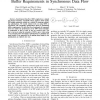Free Online Productivity Tools
i2Speak
i2Symbol
i2OCR
iTex2Img
iWeb2Print
iWeb2Shot
i2Type
iPdf2Split
iPdf2Merge
i2Bopomofo
i2Arabic
i2Style
i2Image
i2PDF
iLatex2Rtf
Sci2ools
FMCAD
2008
Springer
2008
Springer
Scheduling Optimisations for SPIN to Minimise Buffer Requirements in Synchronous Data Flow
Synchronous Data flow (SDF) graphs have a simple and elegant semantics (essentially linear algebra) which makes SDF graphs eminently suitable as a vehicle for studying scheduling optimisations. We extend related work on using SPIN to experiment with scheduling optimisations aimed at minimising buffer requirements. We show that for a benchmark of commonly used case studies the performance of our SPIN based scheduler is comparable to that of state of the art research tools. The key to success is using the semantics of SDF to prove when using (even unsound and/or incomplete) optimisations are justified. The main benefit of our approach lies in gaining deep insight in the optimisations at relatively low cost.
| Added | 26 Oct 2010 |
| Updated | 26 Oct 2010 |
| Type | Conference |
| Year | 2008 |
| Where | FMCAD |
| Authors | Pieter H. Hartel, Theo C. Ruys, Marc C. W. Geilen |
Comments (0)

